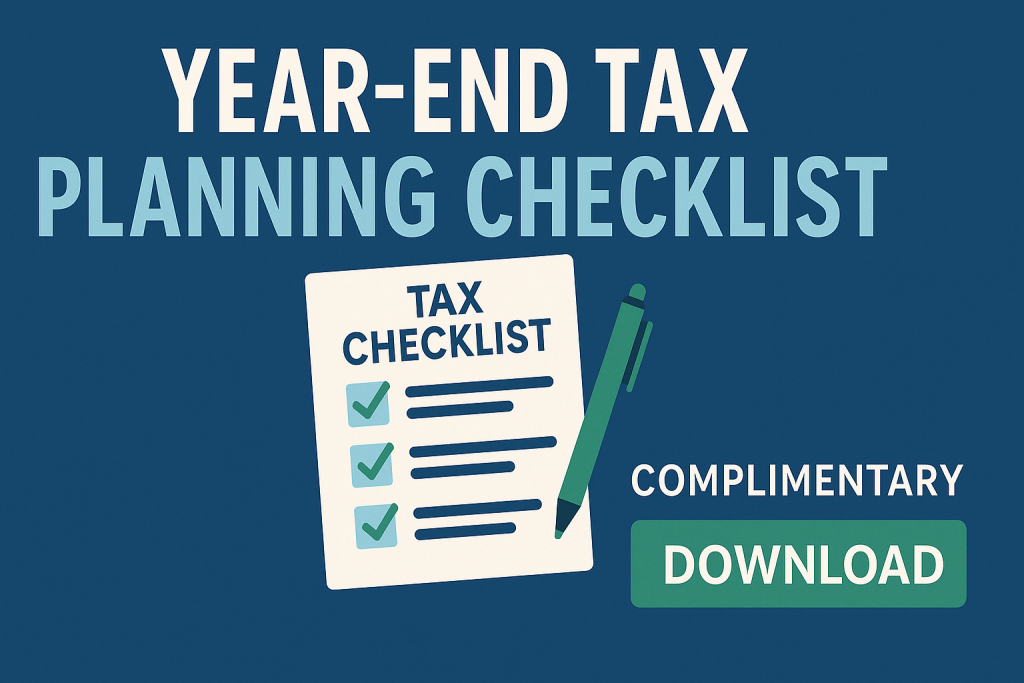Every December, entrepreneurs swear they’ll get their finances dialed in before the year ends — for tax savings, for peace of mind, and for their bottom line.
Then life happens. Holidays. Projects. Good intentions getting pushed aside by interruptions.
Then the calendar flips and you’re staring at a tax bill wondering what happened.
Most people treat their finances like they treat the check engine light in their car. Ignore it long enough and hope it goes away.
But money doesn’t work like that. Taxes don’t work like that. And wealth doesn’t work like that.
So, let’s simplify this.
Here’s exactly what to do before the year ends, key moves that take more time but still matter, and things to absolutely get handled to avoid giving the IRS a tip they never asked for (but are always happy to take).
Start With the Essentials: Your Books. Your Numbers
If your financial numbers aren’t current, your choices are limited.
Look, you can’t make intelligent decisions with incomplete data — it’s like trying to navigate with half a map and hoping the missing roads magically appear.
In fact, I’ve watched brilliant entrepreneurs lose thousands simply because they were guessing instead of knowing.
But when your numbers are clean, something powerful happens.
You see the truth.
You spot patterns.
You catch mistakes before they cost you.
And then…
That clarity gives you confidence.
Newfound confidence creates better decisions.
Better decisions create cash flow.
Without timely data, you’re far more likely to overpay in tax. If you’re talking to your accountant in 2026 about 2025, you missed the window, because at that point it’s simply tax filing (not tax strategy).
Now let me be clear, this isn’t just about spreadsheets. It’s about awareness of what’s going on in your life and business so that you keep more of your hard earned money (wouldn’t you rather take your family on a trip to the Bahamas vs tipping Uncle Sam?)
High Impact Tax Moves To Make Before December 31
#1: Prepay Expenses You Know Are Coming
This works beautifully for cash basis businesses.
If the expense is legitimate, necessary, and already planned for next year, you can prepay and take the deduction now on things like:
- Rent.
- Software.
- Supplies.
- Contractors.
- Insurance.
- Coaching.
- Professional fees.
But remember, don’t let the tax tail wag the dog.
Spending a dollar to save 35 cents is not a winning strategy, and a bad purchase is still a bad purchase, even if it shows up on a Schedule C.
#2: QBI Deduction Planning (Section 199A)
QBI Planning under Section 199A is one of the most practical, widely accessible, and impactful tax strategies for small business owners.
Unlike QSBS, the QBI deduction applies to many entrepreneurs today — not just those planning for an exit far in the future.
The Qualified Business Income Deduction allows eligible business owners to deduct up to 20 percent of their qualified business income from pass-through entities. This includes:
- Sole proprietors
- Partnerships
- S Corporations
- Some LLCs taxed as any of the above
For many entrepreneurs, the QBI deduction is one of the simplest ways to reduce taxable income without adding complexity.
#3: Review Subscriptions and Recurring Charges
This is simple, but it can really add up — especially if we consider opportunity cost.
What could the money become if it were invested instead of wasted?
Free trials that weren’t free.
Software you forgot you subscribed to.
Apps you haven’t opened in months.
This takes ten minutes and often saves hundreds. Sometimes thousands.
And if you have too many you can’t keep track of, there’s an easy tool called Rocket Money you can try that’ll show you your subscriptions and even offer to cancel them for you.
#4: Hire Your Kids Before December 31
This is easily one of the most elegant strategies available.
You get a deduction.
Your kids get tax-free income up to the standard deduction.
You move money from your highest bracket to their lowest.
And you teach them work ethic before the world teaches them entitlement.
The key is simple: your kids must work.
Real tasks. Real contribution. Documented just like any other employee.
I use and love this tax strategy not just for the financial benefits, but because it lends itself nicely to your family legacy, teaching your kids, giving you an opportunity to work with them, and yes — making them earn that new video game system or toy.
#5: The Augusta Rule (Section 280A)
This is one of our most popular and easy to implement strategies.
You can rent your home to your business for up to 14 days per year at fair market value.
Your business gets a deduction.
You personally receive tax-free income.
Use it for planning meetings, workshops, team gatherings, content days, or shooting video.
Get it done before years end. If you did this earlier in the year, print a rental agreement, fill it out, send the money and save.
#6: Home Office Deduction
Many small business owners are already aware of this one, but it’s still worth mentioning.
The home office deduction is for a dedicated space used exclusively for business, and can reduce taxes on:
- Internet
- Utilities
- Rent
- Mortgage interest
- Repairs
- Insurance
- Depreciation
If you haven’t already, make sure you get this one on your books.
#7: Use R&D Credits
R&D credits sound like something reserved for tech firms or labs, but in reality, they apply to more entrepreneurs than most people realize.
Better yet, they can often be claimed for prior years, sometimes going back three tax years, which means real cash refunds for work you already did.
The impact can be substantial… tens of thousands for some businesses, and six figures for those with larger teams or ongoing development work.
The process is also far easier than people imagine.
A good R&D specialist handles the heavy lifting by documenting your qualifying activities, calculating the credit, and preparing the filings.
For entrepreneurs who create content, build frameworks, improve processes, design training, develop software, or innovate in their industry, R&D credits can be one of the highest-ROI tax moves available.
We’re not talking about a small chunk of change here either — I was able to get $91,000 dollars in R&D credits a few years ago. I was able to go back, amend past returns, and get money that was rightfully mine.
#8: Section 179 and Bonus Depreciation
This one is a really powerful tool when used intentionally.
But be aware — it isn’t about impulsive spending; it’s about accelerating deductions on equipment that truly supports your production.
Think:
- Cameras
- Computers
- Lighting
- Software servers
- Office furniture etc.
Not the toy you want, but the tool you need.
My friend Eric loves cars. So, he buys one each year and does the Section 179 to write off the whole thing immediately.
If you aren’t like Eric, and don’t love cars, know how to buy them for the right price, or sell them later, this may not make sense.
But if you are a doctor and some equipment would make a big difference in what you can charge, then this is for you.
The rule is buy what elevates your work, not what inflates your ego.
#9: Mileage, Meals, and Travel
One of the most missed deductions is travel.
Need to do your annual retreat or corporate meetings?
Maybe you think better in another state or country without distractions.
You can deduct travel tied to legitimate business strategy and meals tied to actual business discussions.
#10: Review Your Entity Structure
If you are a sole proprietor taking your deductions on a schedule C, you have a 400% higher chance of audit. 400 percent. Plus, you have unlimited liability.
Year-end is the perfect time to review your ownership.
- Are you in a partnership that an LLC would be the best structure?
- Or are you in a cash cow business with no business partners and might want to consider an S Corp.
- Or maybe you want to sell your business and would like to utilize section 1202 to sell for millions tax free.
Things to consider include the type of Corp, reasonable compensation adjustments, payroll setup, ownership changes, documentation cleanup, and liability protection.
This can be the difference of being protected or exposed, saving tax or overpaying, and having peace of mind or continued worry.
The Money Moves That Take More Time But Still Pay
Now that we’ve covered the major tax moves you can make, let’s look at some of the foundational upgrades you can make that create long-term tax savings, reduce liability, and expand your financial capacity.
When these pieces are in place, your money becomes easier to manage, easier to protect, and easier to grow.
But keep in mind, these are not moves you can make overnight… However, ignoring them costs far more over the long term.
#1: Loan Efficiency Planning
Most entrepreneurs simply make minimum payments without ever evaluating the true cost of their loans. Loan efficiency planning identifies:
- Which loans cost you the most in interest rather than principle.
- Which loans create unnecessary cash drag because of poor structure.
- Whether refinancing makes sense (not always).
- Whether to accelerate payoff or redirect cash elsewhere for better returns.
- How to re-sequence or restructure loans to improve cash flow without sacrificing liquidity.
The Cash Flow Index is one of the simplest and most revealing tools for evaluating your loans.
It cuts through the noise and tells you exactly which debts drain your cash flow and which ones you can safely ignore.
Cash Flow Index = loan balance (÷) minimum monthly payment
The higher the number, the more efficient the loan is.
A high Cash Flow Index means the payment is small relative to the loan balance, so your dollars are working efficiently and there’s no need to rush payoff.
A low Index means the loan is eating your cash flow, strangling your monthly burn, and deserves attention.
This keeps you from making emotional decisions around loans, like paying off the wrong loans first or throwing money at balances that don’t improve your financial picture.
Instead of chasing interest rates or following outdated advice, the Cash Flow Index prioritizes your peace of mind and puts your dollars where they create the most flow, not the most fear.
#2: Insurance Review
Insurance is often treated like a set-it-and-forget-it line item, yet it is one of the most powerful tools for reducing risk.
A proper insurance review covers:
- Liability limits that match your true exposure.
- Umbrella coverage that protects you against catastrophic risk.
- Increase deductibles to reduce premiums.
- Business policies that match your current operations (not last year’s version).
- Key person insurance for essential team members.
- Disability and long-term care planning depending on age and income.
Nancy from Texas had two different companies providing her coverage, no excess liability umbrella policy, and low deductibles.
By simply raising her deductible by $900, choosing one company to get the multipolicy discount, and using an umbrella policy, she was able to save $703 per year and get $900,000 more in coverage.
That’s the power of smart policy design. Remember, the goal is to transfer catastrophic risk, so you don’t carry it yourself.
#3: Legal Updates
Legal strategy is not something you update once in a lifetime. It evolves as your income, assets, and family structure evolve.
A proper legal update includes:
- Reviewing and updating your operating agreements (get more detailed, intentional, and customized).
- Confirming your asset protection is current (trusts, entities, titling).
- Updating your living trust or will if family situations changed.
- Ensuring beneficiary designations match your intentions.
- Adding board minutes and documentation that support your tax positions and corporate compliance.
- Reviewing intellectual property protections (copyright, trademarks, etc.).
These kinds of simple updates now prevent expensive problems later.
#4: Advanced Strategy Work
Once the basics are solid, advanced strategy amplifies everything.
Here are just a few to consider:
- Family Crest and Constitution; building your legacy tools that lead to lasting wealth.
- Using properly structured whole life insurance to store liquidity and expand capacity.
- Cost Segregation Studies: Accelerating depreciation for real estate investors.
- Multi-entity planning: Separating liability, intellectual property, operations, and investments.
- Philanthropic strategy: Charitable trusts, donor-advised funds, or foundations.
Not sure which strategies are best for you?
If you have a successful business and you want to take it — and your financial strategy to the next level, watch the video here about Multiplier and see if you’re a fit.
We’ve had some incredible wins for people in the program lately — like one client who turned a $1.75M personal residence into a short-term rental and saved over $150K in taxes with cost segregation and bonus depreciation.
Or a chiropractor who freed up $2,300-$2,700 per month just by plugging leaks across tax, debt, and insurance with a few simple techniques made possible by new technology.
We also put together a complimentary Year-End Tax Planning Checklist that you can download here.
The Real Win
Year-end is not about squeezing every deduction possible. It’s about eliminating uncertainty.
Clarity. Confidence. Control.
Wealth is built by awareness, structure, and intention.
Thanks for reading, and have a wonderful Thanksgiving.




